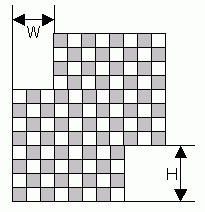| acmsguru |
|---|
| Finished |
→ Problem tags
No tags yet
No tag edit access
The problem statement has recently been changed. View the changes.
×
241. The United Fields of Chessboardia
time limit per test: 0.25 sec.
memory limit per test: 4096 KB
memory limit per test: 4096 KB
input: standard
output: standard
output: standard
Little boy Vasya likes to play chess very much. Every Wednesday and Saturday at four o'clock after midday he goes to "An Check-Mate" (ACM) chess Club for five hours. Here Vasya solves many interesting chess problems and tasks.
Vasya has a great skill of that. He proves this skill everyday. Now, he can solve any simple chess problem faster than any his classmate. But he doesn't know how to solve difficult chess problems, and wants to find out a way to learn that. His trainer said, that the only way to learn how to solve difficult problem - is to know how others do that. And Vasya has thought up a problem for solving by some clever man. Please solve it and help Vasya to make an self-improvement.
Trying to create a really difficult problem Vasya decided not to use standard 8x8 chessboard.
Consider two chessboards NxN and MxM aligned to integer grid such that the left-bottom corner of the second chessboard located not to the bottom and not to the left from the left-bottom corner of the first chessboard. Let us call horizontal distance the number of columns located between two corners. Analogically, we will define the vertical distance (look at figure for clearance). Your task is, given sizes of chessboards, horizontal and vertical distances between their left-bottom corners and number K, to calculate a number of ways to place K rooks in peaceful position on union of these two boards. Position is called peaceful, if any two rooks don't attack each other. Rooks attack each other if located at same vertical or horizontal.

Vasya has a great skill of that. He proves this skill everyday. Now, he can solve any simple chess problem faster than any his classmate. But he doesn't know how to solve difficult chess problems, and wants to find out a way to learn that. His trainer said, that the only way to learn how to solve difficult problem - is to know how others do that. And Vasya has thought up a problem for solving by some clever man. Please solve it and help Vasya to make an self-improvement.
Trying to create a really difficult problem Vasya decided not to use standard 8x8 chessboard.
Consider two chessboards NxN and MxM aligned to integer grid such that the left-bottom corner of the second chessboard located not to the bottom and not to the left from the left-bottom corner of the first chessboard. Let us call horizontal distance the number of columns located between two corners. Analogically, we will define the vertical distance (look at figure for clearance). Your task is, given sizes of chessboards, horizontal and vertical distances between their left-bottom corners and number K, to calculate a number of ways to place K rooks in peaceful position on union of these two boards. Position is called peaceful, if any two rooks don't attack each other. Rooks attack each other if located at same vertical or horizontal.

Input
On first line of input file, there are sizes of chessboards, N and M respectively (0<=N,M<=20), horizontal and vertical distances between left-bottom corners of chessboards, W and H (0<=W,H<=10^9) and K - number of rooks (0<=K<=10^9).
Output
First line of output file must contain only one number - quantity of peaceful positions.
Sample test(s)
Input
Test #1
8 2 6 8 1
Test #2
8 8 3 4 1
8 2 6 8 1
Test #2
8 8 3 4 1
Output
Test #1
68
Test #2
108
68
Test #2
108
| Author: | Alexey Preobrajensky |
| Resource: | --- |
| Date: | October, 2003 |
Codeforces (c) Copyright 2010-2024 Mike Mirzayanov
The only programming contests Web 2.0 platform
Server time: Nov/22/2024 18:55:33 (j2).
Desktop version, switch to mobile version.
Supported by
User lists


| Name |
|---|




